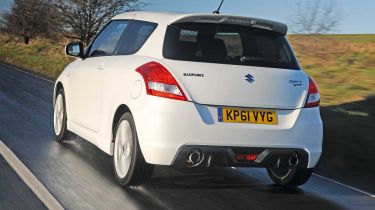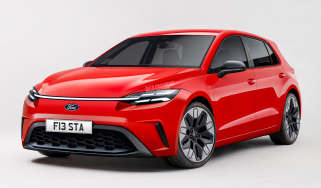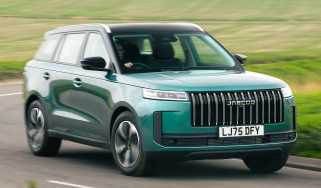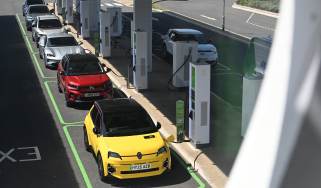Suzuki Swift Sport
It’s more grown-up, but does new hatch deliver the same driving thrills as before?
Small, but perfectly formed – that seems to be the motto Suzuki’s designers followed when penning the Swift. While the car demands some compromises in terms of space, the Sport version reaps the rewards of those compact dimensions and light weight – it tips the scales at only 1,045kg, which is a significant 95kg less than the Clio.
You still get plenty of racy kit, though, so if you’re a fully paid-up member of the hot-hatch fan club, you won’t be disappointed. Body-coloured sill extensions, 17-inch alloys and twin exhausts combine with tinted side windows and a spoiler to leave onlookers in no doubt about the car’s intentions.
There are only five colour options (one more than on the Renault), yet for all the Swift’s extra kit, you’re better off going for the garish stripes of the Clio Gordini if you want to make a strong visual statement. Still, if you prefer a more restrained approach, the Suzuki has lots to offer, including a very grown-up interior. There’s little to set it apart from lesser models, but that’s not a problem, as the overall design and quality of the cabin are impressive.
Sports seats and stainless-steel pedals add a touch of pizzazz to the solid fixtures and fittings and the driving position is good. Luxuries include climate control, a multifunction steering wheel, iPod connectivity and Bluetooth. The Renault isn’t exactly spartan, but the Suzuki’s interior is much snazzier.
Used - available now

2024 Nissan
Ariya
12,471 milesAutomaticElectric
Cash £25,490
2021 Lexus
UX 300e
39,392 milesAutomaticElectric
Cash £16,950
2023 Hyundai
i30
23,040 milesManualPetrol1.0L
Cash £14,801
2021 Vauxhall
Mokka
16,283 milesAutomaticPetrol1.2L
Cash £15,795However, the Swift lacks space – its short body means you don’t get as much rear legroom as in the Clio. Boot space is also disappointing. The 211-litre boot is much smaller than the Renault’s 288 litres, so if you need to carry more than a few well stocked shopping bags, you may need to use the back seats.
The Swift Sport isn’t really meant for supermarket car parks, though. Its various engine and chassis tweaks are designed to make the most of the driving experience.
And they’re largely successful, too. The 1.6-litre engine is a development of the one fitted to the old model, but a new variable intake system and a few other modifications have raised power from 123bhp to 134bhp – that’s 8bhp more than the Clio. The changes have also improved efficiency: CO2 emissions fall to 147g/km, making the Suzuki cleaner and cheaper to tax than its rival.
This was backed up by our findings, as the Swift won the economy battle, returning 30.2mpg over a day of hard driving around Salisbury Plain and our test track. The Renault did 29mpg, and while you’ll likely see better returns in day-to-day use for both cars, the evidence suggests the Swift is more frugal.
But does it provide more driving thrills? For starters, the Suzuki’s engine is livelier and more engaging. Once you hit 4,000rpm, you hear the kind of pulse-raising engine note that’s essential in a frenetic hot hatch – something that’s missing from the Renault.
A higher power output and lighter weight give the Swift the edge for pace, too. It beat the Clio Gordini by 1.4 seconds in the sprint from 0-60mph, with a time of 8.2 seconds, and was faster than the Renault in our third and fourth-gear acceleration tests. The Suzuki loses out in higher gears, due to longer ratios.
The firm suspension works well, minimising body roll and making the Swift lively, agile and grippy. A positive gearshift and precise steering add to the fun, but the Suzuki is not as stable as the Renault on rough roads or under heavy braking.
Worse still, some of the old Swift Sport magic has gone. The new model has more neutral handling than before, so if you lift off the throttle sharply mid-corner, it won’t upset the car’s composure. This makes it safer, but not as fun.
Details
Chart position: 1
WHY: The Swift Sport has always performed well in our tests as it’s so much fun. This all-new model promises to be better still, plus it’s £500 cheaper than the Clio.



